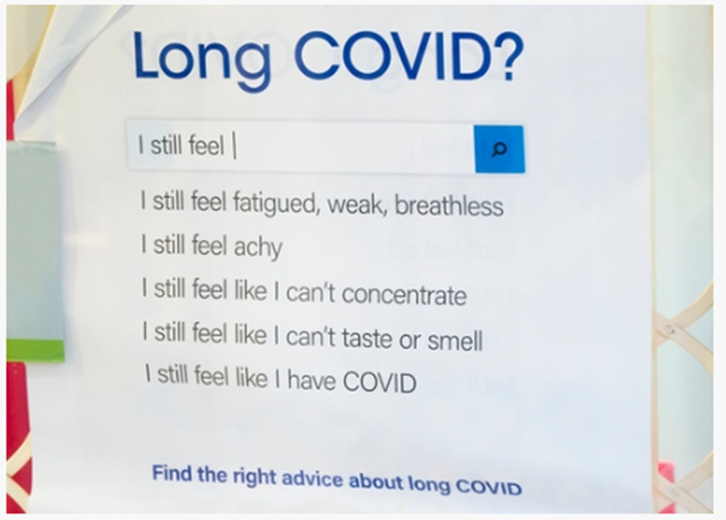Covid is Here to Stay
It’s pretty clear that COVID is here to stay. It continues to not only infect new cases but continues to wreak havoc in the already infected longer than the traditional medical model previously considered possible. Long COVID is a poorly understood constellation of symptoms (both mental and physical) that persist for more than 2 months after infection of COVID that significantly impacts a person’s life and isn’t explained by an alternative diagnosis (Mikkelsen & Abramoff, 2023).
Long Covid Symptoms
The most common symptoms in long COVID are fatigue, difficulty breathing, joint pain, chest pain, and cough (Sudre & Et.al, 2020), but we are often seeing brain fog, anxiety, dizziness, and difficulty in regulating heart rate and blood pressure. Symptoms can also change day to day. We don’t know what causes long COVID and its unclear who is at most risk of developing long COVID due to conflicting reports. What we do know is 87% of patients hospitalized with COVID will still experience symptoms after 2 months (Carfi, Bernabei, & Landi, 2020), so this is not an uncommon issue. Meanwhile, most patients do start to see improvement in their symptoms in 4-9 months (Mikkelsen & Abramoff, 2023) even without intervention.
Why Do Some People Get It?
So, what is causing long COVID? We aren’t sure. There are a few ideas, but it boils down to the following themes: reactivation/reemergence of COVID or other viral illnesses like Epstein Barr virus (Gold, Okyay, Licht, & Hurley, 2021). Other contributing factors are immune system dysregulation, energy metabolism defects, and imbalances of pro and anti-inflammatory processes.
Treatment Options
Fortunately, as naturopathic physicians, we are very used to treating many of these proposed causes of chronic viral infections naturally. Data shows glutathione/NAC, antioxidants, quercetin, curcumin, magnesium all have potential to balance inflammation and treat spike protein related pathologies (Halma & Plothe, 2023). We can also use Ozone IVs and rectal insufflations to modulate inflammation and help the immune system to kill COVID viral particles (Cenci, Macchia, & ET.al, 2022). We can also use antiviral herbs like cat’s claw, lemon balm, and licorice that have evidence of very robust antiviral properties. We can use nutrients like acetyl l carnitine, alpha lipoic acid, vitamin C to help restore the energy metabolism defects.
Ultimately, treatment isn’t (and shouldn’t) be once size fits all. Often we are supporting multiple body systems for overall improved health – helping the body to heal itself. We customize our approach of testing and treatments to help address your long COVID symptoms and support your healing.
References
Carfi, A., Bernabei, R., & Landi, F. (2020, July 9). Persistent Symptoms in Patients After Acute COVID-19. Retrieved from JAMA Network: https://jamanetwork.com/journals/jama/fullarticle/2768351
Cenci, A., Macchia, I., & ET.al. (2022, April 21). Mechanisms of Action of Ozone Therapy in Emerging Viral Diseases: Immunomodulatory Effects and Therapeutic Advantages With Reference to SARS-CoV-2. Retrieved from National Library of Medicine: https://pubmed.ncbi.nlm.nih.gov/35531273/
Gold, J. E., Okyay, R. A., Licht, W. E., & Hurley, D. J. (2021, June 17). Investigation of Long COVID Prevalence and Its Relationship to Epstein-Barr Virus Reactivation. Retrieved from National Library of Medicine: https://www.ncbi.nlm.nih.gov/pmc/articles/PMC8233978/
Halma, M. T., & Plothe, C. (2023, May 17). Strategies for the Management of Spike Protein-Related Pathology. Retrieved from National Library of Medicine: https://pubmed.ncbi.nlm.nih.gov/37317282/ Mikkelsen, M. E., & Abramoff, B. (2023, June 19). COVID-19: Evaluation and management of adults with persistent symptoms following acute illness (“Long COVID”). Retrieved from UpToDate: https://www.uptodate.com/contents/covid-19-evaluation-and-management-of-adults-with-persistent-symptoms-following-acute-illness-long-covid/print
Sudre, C. H., & Et.al. (2020, June 16). Symptom clusters in Covid19: A potential clinical prediction tool from the COVID Symptom study app. Retrieved from MedRxiv: https://www.medrxiv.org/content/10.1101/2020.06.12.20129056v1.full

